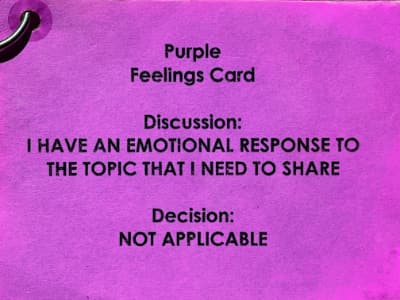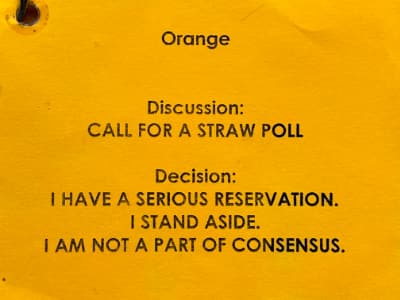Executive summary
For you busy executives 😎.
- Summary
- An explanation of the current card system used in Cascadia HOA meetings.
- Virtues of the present card system.
- Pitfalls of the six card system.
- A simpler three card solution.
- Conclusion.
Now that we are tentatively beginning to hold our community meetings in person again, after two years of virtual presence via Zoom technology, some have suggested that we resume use of the card system in HOA meetings. This post will explain the current system and propose a simpler one that is easier to learn and use.
Given that we have five households that have not had to grapple with learning to use the current six card system, this is an opportune time to consider a change. As this system was, according to my review of the record of HOA consensus, never agreed upon by the HOA formally, it does not have to be revoked or modified by consensus.
The Current Cascadia Card System
In the procedural context, colored cards are used by the meeting facilitator to determine the “stacking” order for the comment queue. In the decision making context they are used primarily to give a visual indication of who supports the decision, who is standing aside, and who is blocking consensus.
When blocking consensus, we expect you to support your position by pointing out where the proposal under consideration is in violation of our mission or guiding principles.
The following is the order of precedence when the facilitator is calling on members to comment:
Red > Purple > Orange > Yellow > Green > Blue.

The Red Card
Discussion – No, this card does not mean you are really, really mad. That’s what the purple card is for. In discussion, it’s used to state an observation relative to a breach of procedure, going overtime, off topic, stuck in emotion, etc. Also, to suggest refocus or punt to a smaller group.
Decision – When testing for consensus, holding up a red card signifies an intention to block the proposal being considered.

The Purple Card
Discussion – That’s right, let us know what you’re really feeling .
🤬🤪🥰😱🥳😩
Decision – Sorry, expression of feelings during the test for consensus is strongly discouraged 😉🧐.

The Orange Card
Discussion – This is used to call for a straw poll. The purpose of a straw poll is to see where the members currently stand with respect to the proposal being discussed.
Decision – In the test for consensus, this card is used to stand aside or abstain from the decision.

The Yellow Card
Discussion – Got a question during discussion? This is the card for you.
Decision – If you need information or clarification during the test for consensus, then we’ve really fouled up somewhere.

The Green Card
Discussion – Yes, please tell us what you know about the matter that is boggling us!
Decision – This is your opportunity to let us know how meh or slightly peeved you are about the proposal up for decision.

The Blue Card
Discussion – Speak your piece, hopefully something to do with the topic at hand.
Decision – This means you are on board, full steam ahead! 🛳
Why use cards at all?
Colored cards give a visual indicator to the meeting facilitator as to how to “stack” participants in the comment queue. In the test for consensus, the facilitator can quickly spot blocks or stand asides and ensure that their objections are noted in the minutes and decide with the group what the next steps should be.
Virtues of the six card system
For savvy users of the six card system, the spectrum of choices available while commenting and deciding is a boon. Some people, for instance, like using the green card in the test for consensus to indicate that they are granting consent with minor caveats.
Pitfalls of the six card system
As a meeting facilitator, I notice even long time members fumbling in search of the appropriate card. It took me a year or two to become comfortable using the cards when I first came to Cascadia. I like to think I’m not stupid, but I sure felt that way in the early meetings.
A simpler card system

The flow in discussion and the test for consensus tends to fall in three different modes:
- stop the discussion or decision
- pause the discussion or decision
- go ahead with the discussion or decision.
Sound familiar? The three card system uses the familiar stoplight metaphor of go, slow, stop; which makes for an easier to remember and shorter set of choices for the meeting attendee to grasp.
The following is an excerpt from: The Consensus Decision Process in Cohousing
Using Colored Cards to Achieve Consensus
Groups have successfully used the following system of colored cards to facilitate the consensus process. There are two contexts in which to use the cards: Procedural and Decision Making.
Procedural uses occur during preliminary discussions of an issue. Participants hold up a card before speaking. The facilitator recognizes them in the following order:
(1) Red (2) Yellow (3) Green
In the procedural context, the cards have the following meanings
- Red means “Stop the Process” (time out) and indicates a breach in agreed upon procedures. Examples include; discussing topics not on the agenda, going overtime, and suggesting that a member of the group is being inconsiderate of the group process. It can also be used when a member feels uncomfortable with the way that the process is proceeding or if they believe that a break would be appropriate. The red card may be raised at any time during discussion.1
- Yellow indicates a member’s ability to clarify some part of the discussion. 2
- Green indicates a member’s desire to make a comment or ask a question.
More than one card may be raised at a time by a single member, but the order of priority listed above is still observed. When there is more than one card of the same color raised, the facilitator ensures that the individuals are heard in the order that the cards have been raised
In the decision-making context the cards have the following meanings
- Green indicates agreement with the proposal under discussion.
- Yellow indicates that the member has reservations but is unwilling to block group consensus because of those reservations.3
- Red indicates the member’s opposition to the proposal at hand and their willingness to block group consensus because of that opposition. When a member/or members use a red card, it becomes his or her responsibility to work with the proposing committee to come up with a solution that will work for everyone.
It is incumbent upon group members to use red cards judiciously within the procedural context, remembering that green cards permit questions and comments. Similarly, in the decision-making context, members should be conscious of the seriousness of blocking consensus and use the red cards only for principled objections. However, when a member strongly believes that the fundamental interests of the group are not being served by a particular decision, the red card should be used as a vote of conscience, even if unpopular.4
Modifications of the above system for Cascadia use
- Calling for a straw poll currently uses the orange card. Since calling for a straw poll is meant to stop the flow of discussion, I believe that the red card can do double duty during discussion.
- We currently use the yellow card for questions. In addition to dealing with clarifying questions before discussion and test for consensus, I believe questions that arise during discussion can be piggybacked on the yellow card, along with clarifications and more information.
- The orange card does not serve to block consensus, therefore the yellow card can be appropriately used for this. Yellow card holders in consensus should have their concerns noted in the meeting minutes.
- Refer to the guiding principles when using the red card in consensus.
Think of the stoplight metaphor when using the three card system. Do I need to pause the discussion with a yellow card to ask a question or provide information? Should I stop the discussion to note a breach of procedure or call for a straw poll?
Conclusion
The Magical Number Seven, Plus or Minus Two
An oft cited paper in psychology The Magical Number Seven, Plus or Minus Two: Some Limits on Our Capacity for Processing Information sets the number seven as the ideal maximum number of variables for our minds to easily juggle. Our current system has a total of 11 meanings for the colored cards, and few members can use them without frequent reference to the explanations printed on the cards. Since we only use the cards for HOA meetings, and some cards get seldom used, it is very easy to forget the appropriate color for the task at hand. The three card system has a total of six meanings, three each for discussion and the test for consensus.
The reason for using cards is to facilitate an easy flow during our meetings. If the cards are acting as a source of confusion or frustration, they are failing in that function.
Missing from the three card system is the purple card for feelings. The truth is that strong feelings are often present throughout discussion and the test for consensus. Rather than corralling our emotions into one segment of discussion, we should refine our perceptions to notice when a member is struggling or in reaction and make a point of acknowledging what we perceive they are feeling and confirm that we heard what they were saying.

David, do yo have a head fungus? You’re scratching your head a lot!! Oh, now I get it. You’re reacting to the six card system.